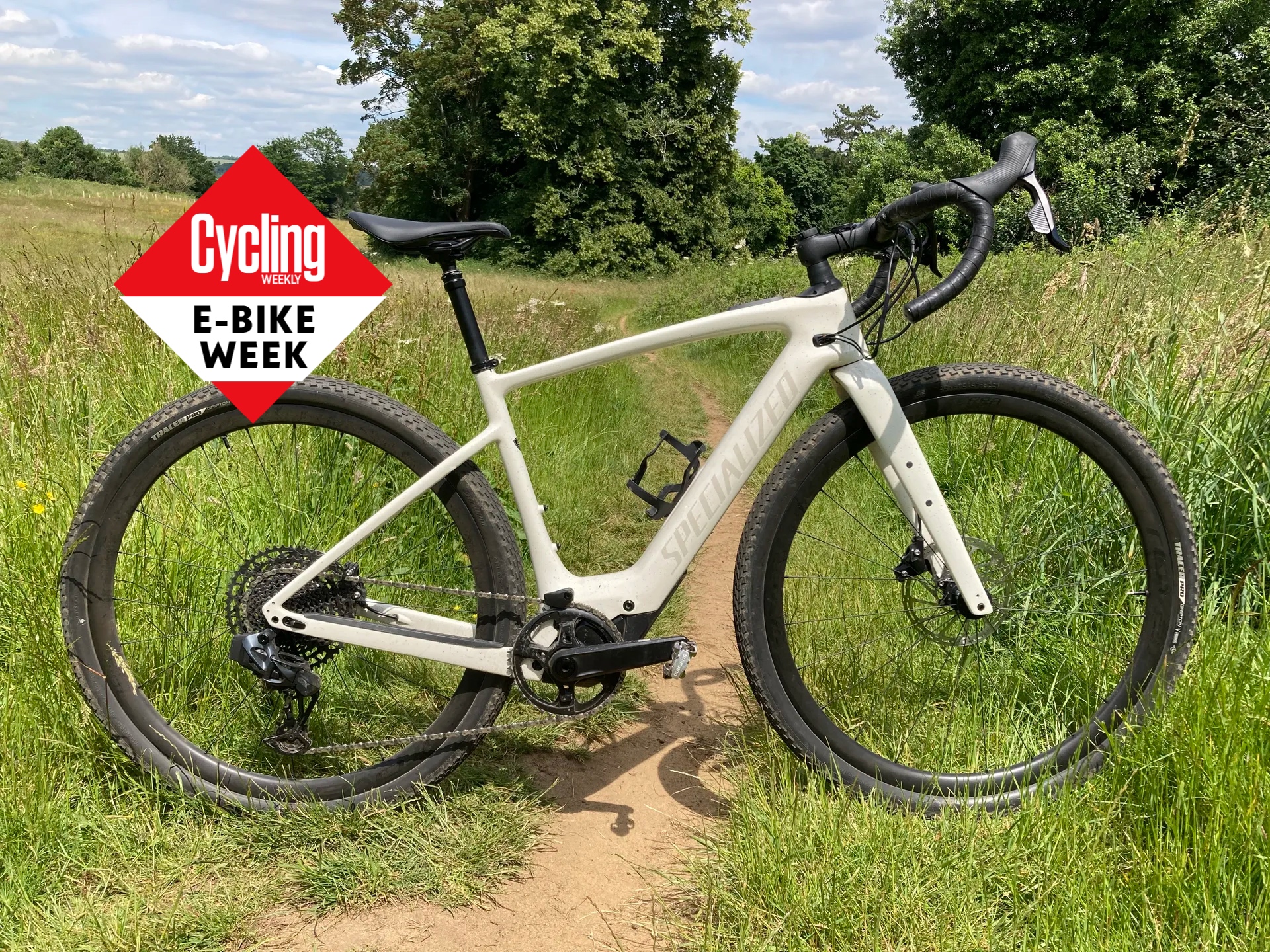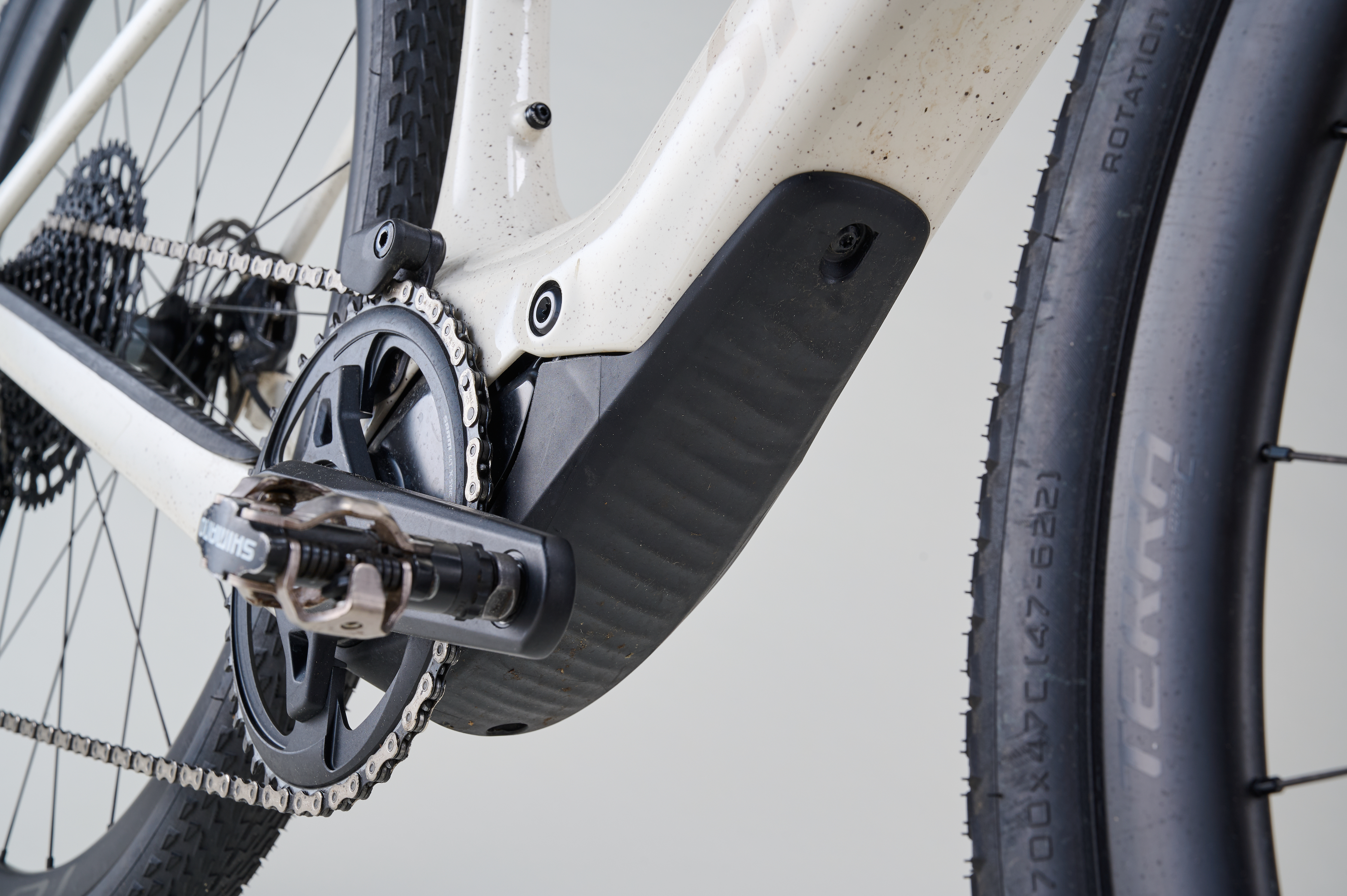
A bike that began its existence in road form, the Creo SL could not have strayed further from that path. This latest iteration is big, it's burly, and it looks ready to take on just about anything this side of a World Cup downhill course.
Front suspension? Check. (It's there in the head tube). Dropper post? Check. Tyres that wouldn't look out of place on a hardtail? Also, check.
But this, the Creo SL Expert Carbon (let's call it by its full name at least once) doesn't look unwieldy – or in the least bit slow. It's compact and muscular and well dressed, with geometry that makes it look as though it'd do pretty well in a gravel race (though it's an ebike, so it almost certainly would).
Released towards the end of last year, the Creo SL is an upgrade from its predecessor in a multitude of ways. Perhaps most obviously, it has an improved motor with more power and torque. On top of that, the frame has been redesigned to take much bigger tyres.
Let's look at the bike in a bit more detail.

The frame in detail
It's finished in 'Gloss Black Pearl Birch Black Pearl Speckle'. The valuable seconds lost off your existence telling your buddy the colour are repaid to some extent by the fact you can enjoy a pale paintjob without it being spoiled by the first flecks of dirt.
This is very much a gravel frame, even taking the big tyres out of the equation. The clearances are huge. Enough, in fact, to take 2.2in (57mm) tyres, not that Spesh goes as far as that with the standard 47mm offerings.
Low rider-style fork mounts are in place for bikepacking overnighters, and dropout eyelets for rear racks are also present. There are also mounts for a seat stay bridge. A top tube bag is not an option though – it would obscure and likely damage the electronic display, and the rubber Future Shock suspension boot wouldn't like it either.
At which point, let's talk about that Future Shock. The one here is the most premium of the three Future Shock designs, and features six levels of adjustment accessed by a dial on top of the stem.
In terms of geometry, this newer version of the Creo features a slightly slacker frame than its predecessor, making it a more capable gravel-tamer. The wheelbase has gone out from 1,020mm to 1,059, while the head angle is reduced by a degree-and-a-half to 71°. Stack and reach are 607mm and 392mm respectively, making for what feels to me like a neutral position well suited to the task at hand.

Components & Wheels
It's no surprise on such a clear-cut gravel bike to find a single chainring (44t) up front, and this is paired with a 12-speed cassette, with 11-50 teeth to choose from. The whole drivetrain is SRAM eTap AXS, with Rival at the levers and calipers and Eagle chainring and rear mech. The brakes are hydraulic discs, of course.
Wheels are built with Roval Terra C carbon rims that feature a 25mm internal width, with DT Swiss hubs and spokes. Notably, this newer version of the Creo eschews the Boost hub spacing standard used by the previous incarnation, making it compatible with a good deal more wheels than before.
The 47mm tyres are Specialized's own Tracer Pro. They're summer tyres, really; three-season at a push.
Finishing kit is in-house too, with a short-nosed Body Geometry Power Expert Saddle and 42cm Hover handlebars with a slight rise. The Trans-X dropper seatpost completes the picture, offering 50mm of travel.

The Motor
Specialized SL 1.2 motor is another upgrade for this newest version of the Creo, with the previous bike using the SL 1.1.
The new item offers 320 watts of power driving 50nM of torque – considerably more than the previous unit's 240 watts and 35nM. In turn the motor is powered by a 320Wh battery hidden in that chunky down tube. This can be supplemented by a proprietary external Range Extender battery (£295) that fits in the bottle cage in the pictures and offers half as much battery life again.
The bumf for the bike quotes a range of up to five hours, but it varies, of course. Inputting my vital stats into Specialized's range finder gave me a 90km (54-mile) range for a hilly ride in Eco mode. But if I dropped 20 kilos I'd get another 20km. It's a useful tool.
Q-factor is now 169mm – less than the previous Creo but also 18mm more, for example, than Shimano's GRX crankset.
The top tube display (or Mastermind Turbo Connect Unit to give it its full name) offers all the key info you're after – battery health, mode, speed and more – and it can be tailored pretty much exactly as you'd like by pairing it with the Specialized app. This alsos enables you to record your rides and dial in the assistance you'd like from the motor.
Paired to all of this is a pair of blip buttons on the rear of the handlebar, which allow the rider to cycle through power modes more easily than with the single button on the TCU, and without taking a hand off the bars.

The Ride
Even in Eco mode, the assistance kicks in rapidly from the off. Out on a flat road with no wind, you'll need to get past the legal 25kph (15.5mph) speed limit for assistance before feeling like you're doing much in the way of work – the Creo just makes it that easy.
Of course, getting up to that speed is a doddle with the power assistance, which feathers away almost unnoticed when you hit the limit, rather than cutting out abruptly and leaving the rider suddenly feeling like half the cyclist they were a moment before.
On the woodland paths that mostly pass for gravel in my part of the world, the Creo SL makes riding an absolute joy. The uphill drags with slow, difficult surfaces that mean minutes of unpleasant toil on a standard machine are made light work of, with the 47mm Tracer Pro tyres playing a significant part here. Combined with the motor, and the Future Shock, they make choosing a line so much easier. Almost any line, in fact, becomes open to you.
Steeper hills – usually my bête noir as a rider well into 90-something kilos – found me calling on the Sport mode at times, even if Eco still made a useful difference.
Like everything else, steep hills are best taken seated on this bike, given that (on any bike) there's a pronounced dead spot at the bottom of each pedal rev which doesn't make for the smoothest power delivery once you bring a power-matching motor into play.
Sport mode was an absolute hoot, offering all the power I needed and more. Off-road became fun, fun, fun, and all those toils back up to speed after tackling a tricky section were replaced with an exhilaratingly quick return to grin central.
However, I didn't find the highest assistance mode – Turbo – particularly useful. It made a small difference on the steepest hills, but there is a much bigger jump from Eco to Sport than from Sport to Turbo. These jumps can be tuned by the rider, but I really did feel as though Sport gave me all the boost I needed.
The Future Shock was unintrusive. But I've used it enough to wish I had one on all my road and gravel bikes. The tuneablity of the 3.3 version fitted to the Creo SL is a nice touch but I found I kept it resolutely on the softest setting.
Lastly, the SRAM eTap was almost faultless. The changing was quick and smooth – not quite as smooth as on the Roubaix SL8 I rode recently, but fuss-free all the same. The brakes, unsurprisingly, threw up no complaints either.
Perhaps the only misfire are the handlebars. They would definitely benefit from a flare – even just a small one – for added control and ease of riding in the drops. But given I'd like to see flared bars on endurance road bikes too, I probably would say that.
Value
At £7,500 / $9,000 this is not a small-change bike by any means (are any of them these days?); in fact it's getting towards the top end when it comes to gravel ebikes. But the amount of know-how and technology that has gone into this bike feels as though it justifies that price tag.
Clearly, all the know-how and the tech in the world wouldn't count for much if it didn't ultimately produce a high quality and eminently capable machine, but the Creo SL is without doubt both of those things.
In terms of rivals, you could look at the Cannondale Synapse Neo Allroad 1 for £6,000, which features a 600w motor with 55nM of torque, or perhaps the Canyon Grizl:ON CF 9 (£6,699), featuring an 55nM Bosch motor with 400Wh battery.
The Spec
Frame: FACT 11r carbon, front/rear thru-axles, fully integrated down tube battery
Fork: Future Shock 3.3
Motor: Specialized SL 1.2, 250 watts / 50nM torque with 320Wh battery
Shifters: SRAM Rival eTAP AXS, hydraulic disc
Rear mech: SRAM GX Eagle
Brake calipers: SRAM Rival eTAP AXS, hydraulic disc
Wheels: Roval Terra C, 25mm internal width carbon rim, 32mm depth, DT 370 hub
Tyres: Specialized Tracer Pro, 47mm
Saddle: Body Geometry Power Expert
Handlebars: Specialized Adventure Gear Hover
Stem: Future Stem Pro
Seatpost: Trans-X Dropper, 50mm Travel
Weight: 14.1kg (56cm)







